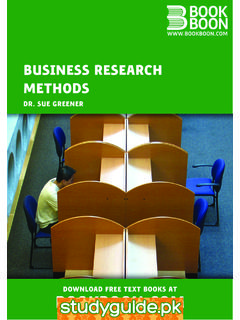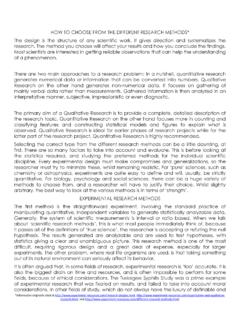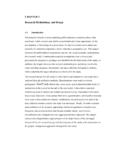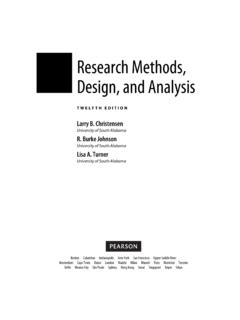Transcription of Research Methods Handbook - CLES
1 Research Methods HandbookIntroductory guide to Research Methods for social researchStuart MacDonald & Nicola Headlam, CLESCLES23 Centre for Local Economic StrategiesExpress Networks 1 George Leigh StreetManchester M4 5 DLtel 0161 236 7036 fax 0161 236 is a registered charity Company limited by guarantee no. 4242937 vat no. 451 4033 86 CLES Consulting is the trading name of CLES European Research Network Company limited by guarantee no. 2467769 vat no. 519 493 812 ISBN: 1870053656 The Centre for Local Economic Strategies (CLES) is a not-for-profit think-tank, consultancy and network of subscribing organisations specialising in regeneration, local economic development and local governance, which was founded in CLESP refaceEffective Research Methods are the tools by which information is gath-ered. Without the appropriate design and use of Research Methods , we are unlikely to gather quality information and as such create a shaky foundation to any review, evaluation or future strategy.
2 For CLES, the group of Research Methods contained within this Handbook are the tool box, and like any tools need to be used in the right way - for the right job. Research Methods , if understood and used appropriately can make your job a lot easier. At CLES we use a range of Research Methods in our policy and consultancy work and are skilled in using them. How-ever, we do not believe that the use of Research Methods is the preserve of so called experts and in all instances requires sophisticated knowl-edge and practice. Clearly, to be experts in their use, requires practice, but like any tool, the basic principle behind its use can be understood and applied, by all. Furthermore, for those who have no intention of actually using a Research method, it is important, perhaps in your work in overseeing or commissioning Research activity, to know what the purpose of particular Research Methods are. This enables you to assess the appropriateness of their Handbook , therefore attempts on the one hand to explain and demystify the world of Research Methods , whilst on the other it seeks to provide a starting point for their use.
3 In this, we are not suggesting that using Research Methods is easy, but merely that it can be appreciat-ed and undertaken by practitioners and non- Research experts. We hope you enjoy this Handbook which is linked to our annual training pro-gramme. This Handbook , reflects our wider charitable aim to develop and improve the performance of the regeneration and local economic development sector. In this, we hope this Handbook goes some way in helping to address some of the persistent issues faced by local places and communities and contributes to ensuring positive local McInroyChief Executive, Centre for Local Economic on100% post-consumer recycled paperIntroduction 7 Types of method 8 Quantitative Research Methods 11 Quantitative survey 11 Secondary data collation and analysis 20 Statistical analysis 24 Qualitative Research Methods 35 Social surveys/questionnaires 35 Interviews 39 Discussion Groups 43 Workshops 47 Observation 50 Visual Techniques 53 Research Issues 59 Glossary 61 Contents67We are all users of social Research .
4 How we apprehend and absorb information and use our critical faculties feeds what we believe about the social world. From surveys reported in the media to market Research , opinion poll-ing and large scale datasets such as the British Crime Survey. Social Research Methods are the tools used to explain social phenomena and often it is more possible to challenge conclusions if you are at least conversant with the variety of methodologies and tools is this book about?This book provides an introduction to the reader to a whole range of Research Methods . It aims to introduce a toolkit of Methods , explain-ing how to use them, their appropriateness and some of the pitfalls of using them in practice. The sections explain in turn: What is the method? When should it be used? What do I need to consider? What is the output? How should it be analysed? Examples from practice Pros/Cons Further ReadingThere is also a glossary of technical terms at the back of the should use this book?
5 This Handbook will be useful for those working in local authorities, re-generation partnerships or other public agencies where Research is con-ducted and commissioned. It can help in undertaking Research in the selection of appropriate Methods , making decisions about the mix of Methods , and the planning of a Research strategy where it is necessary to make explicit judgements about a hierarchy of evidence, the weight afforded to the various elements, and how they might combine to give a rounded perspective. It can also help in understanding Research propos-als, and the methodologies presented to address a particular Research question. Introduction89In any form of Research , you will be required to either count things and/or talk to people. We can broadly classify Research Methods using this distinction. These two types of Research method and their output data are classified as: Quantitative - as the name suggests, is concerned with trying to quantify things; it asks questions such as how long , how many or the degree to which.
6 Quantitative Methods look to quantify data and generalise results from a sample of the population of interest. They may look to measure the incidence of various views and opinions in a chosen sample for example or aggregate results. Qualitative concerned with a quality of information, qualitative Methods attempt to gain an understanding of the underlying reasons and motivations for actions and establish how people interpret their experiences and the world around them. Qualitative Methods provide insights into the setting of a problem, generating ideas and/or hypotheses. The following table provides a breakdown of the key features of each of these categorisation of Research method and of methodQuantitativeQualitativeAimThe aim is to count things in an attempt to explain what is aim is a complete, detailed description of what is , prediction, causal explanationsContextualisation, interpretation, understanding perspectives ToolsResearcher uses tools, such as surveys, to collect numerical is the data gathering collectionStructuredUnstructuredOutputDa ta is in the form of numbers and statistics.
7 Data is in the form of words, pictures or objects. SampleUsually a large number of cases representing the population of interest. Randomly selected respondentsUsually a small number of non-representative cases. Respondents selected on their SubjectiveObjective seeks precise measurement & analysis Subjective - individuals interpretation of events is importantResearcher roleResearcher tends to remain objectively separated from the subject matter. Researcher tends to become subjectively immersed in the subject Methods are Research techniques that are used to gather quantitative data, data that can be sorted, classified, measured. This following section outlines the core quantitative Research Methods used in social Research . Quantitative surveyWhat is the method?Surveys are a popular method of collecting primary data. The broad area of survey Research encompasses any measurement procedures that involve asking questions of respondents. They are a flexible tool, which can produce both qualitative and quantitative information depending on how they are structured and analysed.
8 In this section we focus on the quantitative use of surveys, and in later sections we explore the more qualitative use of survey Methods . When should it be used?When you need to generate primary data from a large number of sources to answer your Research question. Surveys are a useful a means of gathering data from businesses, community organisations and resi-dents, and survey Research is one of the most important areas of meas-urement in applied social Research . However, health warnings need to be attached to the use of quantitative surveys and careful consideration needs to be taken before embarking on any large-scale do I need to consider?In undertaking a survey it is important to understand who you want to survey, how you are going to select them, how you are going to survey them, what you want to ask them and how you are going to organise the task. The following section outlines some key considerations that need to be made before embarking on a large-scale A number of questions about the proposed popula-tion for a survey need to be considered.
9 Such as:Quantitative Research Methods 1. How many roads must a man walk down? a) less than 10b) 10 to 20c) more than 20d) don t know1213 Can the population be counted? Some populations will be easy to count, in a given geographical area there will be secondary data sources that will give you a population count (Census), in a membership organisation there may be a list of all members, however in a newly arrived ethnic community such as the recent arrivals of Polish and Eastern European communities there is less chance that you can obtain a reliable count of the population. A bias in your survey results can occur if the survey sample does not accurately represent the population. Having a count of the population is also important in order to establish the significance of your results to allow a generalisation to the population as a whole. Are there language issues? Respondents may have vary-ing capacities for being able to complete written surveys or questionnaires.
10 While telephone and street surveys do not require the respondent to be able to read or write in English, postal surveys involve respondents completing the survey or questionnaire themselves. You should consider the offer of help in self-administered surveys for respondents to complete a form either in person or over the telephone, this will help address potential language or basic skills issues. If surveying an ethnic minority population you may wish to translate questionnaires into community languages, or have people who speak the com-munities language to assist where are the geographic restrictions? The geographic spread of the population to be surveyed will determine the method used for collecting your data. If you are surveying people from a particular location or organisation it may be possible to conduct a survey using an interviewer, however if you have a population sample that is geographically dispersed then you would look to use a different method, such as a telephone or postal survey.










